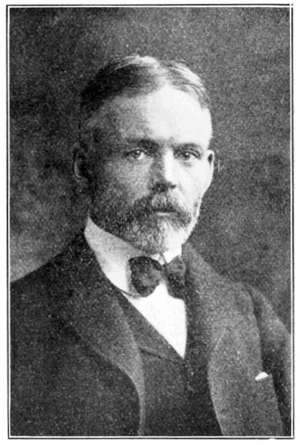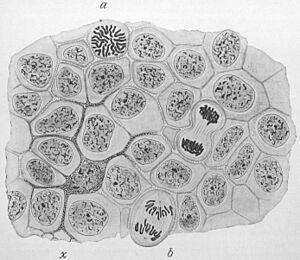Edmund Beecher Wilson facts for kids
Quick facts for kids
Edmund Beecher Wilson
|
|
|---|---|

Wilson in 1908
|
|
| Born | October 19, 1856 |
| Died | March 3, 1939 (aged 82) |
| Alma mater | Yale University Johns Hopkins University |
| Known for | XY sex-determination system |
| Spouse(s) | Anne Maynard Kidder |
| Awards | Daniel Giraud Elliot Medal (1925) Linnean Medal (1928) John J. Carty Award (1936) Fellow of the Royal Society |
| Scientific career | |
| Fields | zoology, genetics, embryology, cytology |
| Institutions | Williams College MIT Bryn Mawr College Columbia University |
| Influenced | Nettie Stevens |
Edmund Beecher Wilson (born October 19, 1856 – died March 3, 1939) was an important American scientist. He studied zoology (the study of animals) and genetics (the study of how traits are passed down).
He wrote a very important book called The Cell. In 1905, he also found out how sex chromosomes work. He discovered that males have XY chromosomes and females have XX chromosomes. Another scientist, Nettie Stevens, made the same discovery around the same time.
Contents
Wilson's Life and Work
Edmund Wilson was born in Geneva, Illinois. His father, Isaac G. Wilson, was a judge.
Education and Early Career
Wilson went to Yale University and studied biology. He graduated in 1878. Later, he earned his Ph.D. (a high-level degree) in biology from Johns Hopkins University in 1881.
He taught at several colleges, including Williams College and the Massachusetts Institute of Technology (MIT). From 1885 to 1891, he was a biology professor at Bryn Mawr College.
Discoveries in Cell Biology
Wilson spent most of his career at Columbia University. He is known as America's first cell biologist. This means he was a pioneer in studying cells, which are the basic building blocks of all living things.
In 1898, he noticed that the early stages of development (called embryos) looked very similar in different animals. He studied how cells divided in animals like molluscs (like snails), flatworms, and annelids (like earthworms). He saw that the same body parts came from the same groups of cells. This led him to believe that these animals must have come from a common ancestor.
In 1907, he was the first to describe extra chromosomes. These are now called B-chromosomes.
Wilson wrote many scientific papers about how embryos develop. He was also the president of the American Association for the Advancement of Science in 1913.
Awards and Recognition
For his book, The Cell in Development and Inheritance, Wilson received the Daniel Giraud Elliot Medal in 1925. This award came from the National Academy of Sciences. Today, the American Society for Cell Biology gives out the E. B. Wilson Medal every year to honor him.
Chromosome Theory of Heredity
Wilson played a role in explaining how chromosomes carry genetic information.
Sutton and Boveri's Ideas
In the early 1900s, two scientists, Walter Sutton and Theodor Boveri, suggested that chromosomes are the units that pass on traits. Sutton was Wilson's student, and Boveri was his friend.
Walter Sutton proposed in 1902 and 1903 that chromosomes, which separate during cell division, are the units of heredity. He thought that the way chromosomes pair up and then separate could explain Mendelian inheritance (how traits are passed from parents to children). Wilson called this idea the "Sutton-Boveri Theory".
Theodor Boveri, a German biologist, also contributed to this idea. In 1904, he stated that chromosomes are "independent entities." This means they keep their identity even when the cell is not dividing. He believed that what goes into the cell's center (the nucleus) is what comes out, meaning chromosomes carry the genetic information.
Books by Wilson
- An Introduction to General Biology (1887), with W. T. Sedgwick
- The Embryology of the Earthworm (1889)
- Amphioxus, and the Mosaic Theory of Development (1893)
- Atlas of Fertilization and Karyokinesis (1895)
- The Cell in Development and Inheritance (1896; second edition, 1915; third edition, 1925)
- The Physical Basis of Life (1923)
See also
 In Spanish: Edmund Beecher Wilson para niños
In Spanish: Edmund Beecher Wilson para niños


